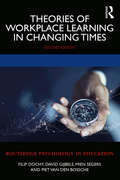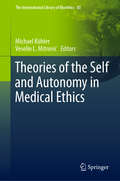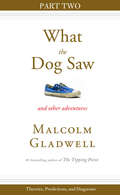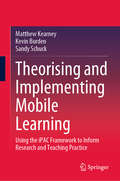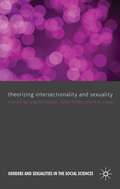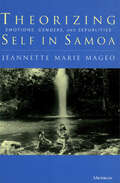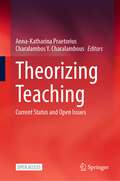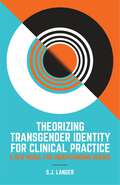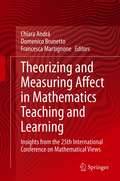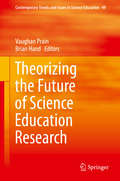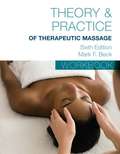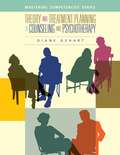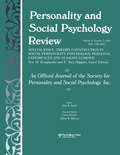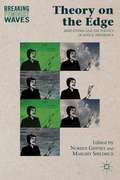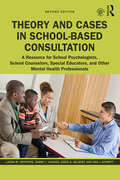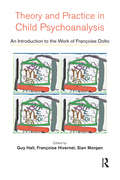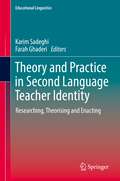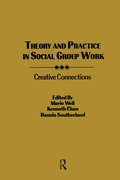- Table View
- List View
Theories of Workplace Learning in Changing Times (Routledge Psychology in Education)
by Filip Dochy David Gijbels Mien Segers Piet Van den BosscheThis book is an expansion and major updating of the highly successful Theories of Learning for the Workplace, first published in 2011. It offers fascinating overviews into some of the most important theories of learning and how they are practically applied to organisational or workplace learning. Each chapter is co-authored by an academic researcher and an expert in business or industry, providing practical case studies combined with a thorough analysis of theories and models of learning. Key figures in education, psychology, and cognitive science present a comprehensive range of conceptual perspectives on learning theory, offering a wealth of new insights to support innovative research directions and innovation in learning, training, and teaching for the upcoming post-Covid-19 decades. Containing overviews of theories from Argyris, Decuyper, Dochy & Segers, Engeström, Ericsson, Kolb, Lave & Wenger, Mezirow, Raes & Boon, Schön, Senge, and Van den Bossche, this book discusses: Learning of employees in the digital era Workplace learning High impact learning Informal learning Adult learning Learning & development didactics (L&D) Reflective practice Transformational learning Experiential learning Deliberate practice Communities of practice Team learning Organisational learning Expansive learning Combining theory and practice, this book will be essential reading for all trainee and practising educational psychologists, organisational psychologists, researchers, and students in the field of lifelong learning, educational policy makers, students, researchers, and teachers in vocational and higher education. It will also be of interest to those involved in training trainers and teacher training.
Theories of the Self and Autonomy in Medical Ethics (The International Library of Bioethics #83)
by Michael Kühler Veselin L. MitrovićThis book engages in a critical discussion on how to respect and promote patients’ autonomy in difficult cases such as palliative care and end-of-life decisions. These cases pose specific epistemic, normative, and practical problems, and the book elucidates the connection between the practical implications of the theoretical debate on respecting autonomy, on the one hand, and specific questions and challenges that arise in medical practice, on the other hand. Given that the idea of personal autonomy includes the notion of authenticity as one of its core components, the book explicitly includes discussions on underlying theories of the self. In doing so, it brings together original contributions and novel insights for “applied” scenarios based on interdisciplinary collaboration between German and Serbian scholars from philosophy, sociology, and law. It is of benefit to anyone cherishing autonomy in medical ethics and medical practice.
Theories, Predictions, and Diagnoses: Part Two from What the Dog Saw
by Malcolm GladwellWhat is the difference between choking and panicking? Why are there dozens of varieties of mustard-but only one variety of ketchup? What do football players teach us about how to hire teachers? What does hair dye tell us about the history of the 20th century? In the past decade, Malcolm Gladwell has written three books that have radically changed how we understand our world and ourselves: The Tipping Point; Blink; and Outliers. Now, in What the Dog Saw, he brings together, for the first time, the best of his writing from The New Yorker over the same period. Here is the bittersweet tale of the inventor of the birth control pill, and the dazzling inventions of the pasta sauce pioneer Howard Moscowitz. Gladwell sits with Ron Popeil, the king of the American kitchen, as he sells rotisserie ovens, and divines the secrets of Cesar Millan, the "dog whisperer" who can calm savage animals with the touch of his hand. He explores intelligence tests and ethnic profiling and "hindsight bias" and why it was that everyone in Silicon Valley once tripped over themselves to hire the same college graduate. "Good writing," Gladwell says in his preface, "does not succeed or fail on the strength of its ability to persuade. It succeeds or fails on the strength of its ability to engage you, to make you think, to give you a glimpse into someone else's head." What the Dog Saw is yet another example of the buoyant spirit and unflagging curiosity that have made Malcolm Gladwell our most brilliant investigator of the hidden extraordinary.
Theorising and Implementing Mobile Learning: Using the iPAC Framework to Inform Research and Teaching Practice
by Sandy Schuck Kevin Burden Matthew KearneyThis book focuses on teaching and learning with mobile technologies, with a particular emphasis on school and teacher education contexts. It explains a robust, highly-acclaimed contemporary mobile pedagogical framework (iPAC) that focuses on three distinct mobile pedagogies: personalisation, authenticity and collaboration. The book shows how mobile pedagogical practice can benefit from use of this framework. It offers numerous cutting-edge research resources and examples that supplement theoretical discussions. It considers directions for future research and practice. Readers will gain insights into the potential of current and emerging learning technologies in school and teacher education.
Theorizing Intersectionality and Sexuality
by Yvette Taylor Sally Hines Mark E. CaseyThis book re-examines political, conceptual and methodological concerns of 'intersectionality', bringing these into conversation with sexuality studies. It explores sexual identifications, politics and inequalities as these (dis)connect across time and place, and are re-constituted in relation to class, disability, ethnicity, gender and age.
Theorizing Self in Samoa: Emotions, Genders, and Sexualities
by Jeannette Marie MageoTheorizing Self in Samoa develops a new theory of the self in culture through a psychological and historical ethnography of Samoa. As in many non-Western cultures, Samoan understandings of the self are more sociocentric--accentuating the social roles that people play--than egocentric--emphasizing individual, interior feelings and perceptions. Yet in Samoa, as in any culture, aspects of the self that are not emphasized in cultural explanations of personhood continually reappear, and must somehow be accounted for. Jeannette Marie Mageo argues that all cultures attempt to encompass these stray experiences of the self within a discursive system. She introduces a way of charting human development through cultural discourses, which helps reveal how emotion, gender, and sexuality are constructed in Samoan society and other cultures, including our own. The second half of the book explores the effects of cultural contact and colonialization on the innermost experience of cultural subjects. With its long ethnographic record, Samoa provides a unique opportunity to consider the dialectic between historical change and personal experience, opening a perspective on the ways in which cultural history is forever leaving its fingerprints upon human lives. Theorizing Self in Samoa marks out important territory for psychological anthropology and students of Oceania, and will appeal also to students and scholars in cultural studies, women's studies, and history. Jeannette Marie Mageo is Associate Professor of Anthropology, Washington State University.
Theorizing Sexual Violence (Routledge Research in Gender and Society)
by Victoria Grace Renée J. HeberleTaking sexual violence in the form of rape and hetero-psychological/physical abuse, trafficking, and harassment as a point of departure, the authors of this volume explore questions about the relationship between sex, sexuality and violence in order to better understand the terms on which women's sexual suffering is perpetuated, thereby undermining their capacity for personhood and autonomy. This volume perceives that while sexual violence as a phenomenon is heavily researched, it remains under-theorized. With anti-essentialist views of gender identity, of subjectivity and agency, and of rationality and consent, the essays study both the dynamics and consequences of sexual violence. The contributing authors blend the insights of postmodern critique with the common goal of theorizing and acting effectively against the material and psychic suffering perpetuated by the rigid rituals of gendered and sexed life.
Theorizing Teaching: Current Status and Open Issues
by Anna-Katharina Praetorius Charalambos Y. CharalambousThis open access book seeks to create a forum for discussing key questions regarding theories on teaching: Which theories of teaching do we have? What are their attributes? What do they contain? How are they generated? How context-sensitive and content-specific do they need to be? Is it possible or even desirable to develop a comprehensive theory of teaching? The book identifies areas of convergence and divergence among the answers to these questions by prominent international scholars in research on teaching. Initiating exchanges among the authors, it then evaluates whether consensus can be reached on the areas of divergence. The book concludes by discussing lessons learned from this endeavor and outlines steps that need to be taken for advancing future work on theorizing teaching. As such, the book is aimed at readers interested in an overview of the theorizing of teaching and key open questions that, if addressed, help to move the field forward.
Theorizing Transgender Identity for Clinical Practice: A New Model for Understanding Gender
by S. J. LangerProviding new approaches for exploring gender identity and expression, this book is ideal for clinical practice with transgender and gender nonconforming/diverse clients. Importantly, it moves beyond the medical model to advance an understanding of transgender subjectivity as a natural variation of gender in humans.The book deepens understanding of the developmental trajectory of trans and gender non-conforming individuals over their lifespan, before and beyond transition, by offering new theories on gender. Drawing on theories from a range of different fields including psychoanalysis, philosophy, neuroscience, consciousness studies, trauma therapy, sex therapy, gender theory, disability studies and trans studies, it illustrates how informed clinical practice can recognise the complexity of gender identity and expression. With chapters on the understanding of core gender through the Free Energy Principle, the foundations of gender in consciousness, a gender algorithm, trauma, mirroring, and sexual functioning, this book works to provide a superior method of clinical practice that can better serve trans communities and our understanding of gender across the population.
Theorizing and Measuring Affect in Mathematics Teaching and Learning: Insights from the 25th International Conference on Mathematical Views
by Chiara Andrà Domenico Brunetto Francesca MartignoneThis book presents a literature review of and a state-of-the-art glimpse into current research on affect-related aspects of teaching and learning in and beyond mathematics classrooms. Then, research presented at the MAVI 25 Conference, which took place in Intra (Italy) in June 2019, is grouped in thematic strands that capture cutting-edge issues related to affective components of learning and teaching mathematics. The concluding chapter summarises the main messages and sketches future directions for research on affect in mathematics education. The book is intended for researchers in mathematics education and especially graduate students and PhD candidates who are interested in emotions, attitudes, motivations, beliefs, needs and values in mathematics education.
Theorizing the Future of Science Education Research (Contemporary Trends and Issues in Science Education #49)
by Brian Hand Vaughan PrainThis book reviews the current state of theoretical accounts of the what and how of science learning in schools. The book starts out by presenting big-picture perspectives on key issues. In these first chapters, it focuses on the range of resources students need to acquire and refine to become successful learners. It examines meaningful learner purposes and processes for doing science, and structural supports to optimize cognitive engagement and success. Subsequent chapters address how particular purposes, resources and experiences can be conceptualized as the basis to understand current practices. They also show how future learning opportunities should be designed, lived and reviewed to promote student engagement/learning. Specific topics include insights from neuro-imaging, actor-network theory, the role of reasoning in claim-making for learning in science, and development of disciplinary literacies, including writing and multi-modal meaning-making. All together the book offers leads to science educators on theoretical perspectives that have yielded valuable insights into science learning. In addition, it proposes new agendas to guide future practices and research in this subject.
Theory And Practice Of Counseling And Psychotherapy
by Gerald CoreyIncorporating the thinking, feeling, and behaving dimensions of human experience, the tenth edition of Corey's best-selling book helps students compare and contrast the therapeutic models expressed in counseling theories. Corey introduces students to the major theories (psychoanalytic, Adlerian, existential, person-centered, Gestalt, reality, behavior, cognitive-behavior, family systems, feminist, postmodern, and integrative approaches) and demonstrates how each theory can be applied to two cases ("Stan" and "Gwen"). With his trademark style, he shows students how to apply theories in practice, and helps them learn to integrate the theories into an individualized counseling style.
Theory And Practice Of HIV Counselling: A Systemic Approach
by Robert Bor Riva Miller Eleanor GoldmanFirst published in 1993. Routledge is an imprint of Taylor & Francis, an informa company.
Theory And Practice Of Therapeutic Massage Workbook (Sixth Edition)
by Mark F. BeckThis Theory & Practice of Therapeutic Massage Workbook has been written to meet the needs, interests, and abilities of students, like you, receiving training In therapeutic massage. This workbook should be used together with Theory & Practice of Therapeutic Massage, Sixth Edition.
Theory And Treatment Planning In Counseling And Psychotherapy
by Diane R. GehartOne of the first books in the field of counseling to use a competency-based approach for teaching counseling and psychotherapy theories, Gehart's text has been developed to help you gain the skills and knowledge outlined in the CACREP 2009 Standards. More specifically, the text introduces counseling and psychotherapy theories using theory-informed case conceptualization as well as treatment planning. The book's assignments empower you to apply theoretical concepts and develop real-world skills as early as possible in your training, resulting in greater mastery of the material.
Theory Construction and Model-Building Skills, Second Edition: A Practical Guide for Social Scientists (Methodology in the Social Sciences)
by James Jaccard Jacob JacobyThis accessible, hands-on text has now been revised and updated, with expanded coverage of topics including how theory may emerge from exploratory data analysis. The book prepares graduate students, new researchers, and even seasoned investigators to develop their own theories and build on existing ones. Concrete strategies are provided to help readers generate ideas, define constructs, and think through relationships and processes that link constructs. Compelling examples from multiple disciplines illustrate the use of quantitative, qualitative, and mixed methods orientations to theory construction. The text also offers practical advice for writing effectively about theories in papers and grant applications. Readers learn by doing via application and concept exercises, demonstration boxes, and practical guidelines. The extensive companion website includes (www.theory-construction.com) PowerPoint slides of all of the book&’s figures, primers on advanced topics, video demonstrations, supplemental exercises, and other resources. New to This Edition *Emergent theory is now covered in mixed methods as well as qualitative approaches, plus in a new chapter on exploratory quantitative methods that can help generate new theory through data mining. *Chapter on whether and how to revise a theory when faced with disconfirmatory data. *Two chapters on the theoretical underpinnings of measurement practices. *New or expanded discussions of what constitutes a theoretical contribution, conceptual logic models, thought experiments, and more. Pedagogical Features *Application and concept exercises in every chapter. *Lists of key terms and engaging topical boxes. *Annotated suggestions for further reading. *New companion website with rich resources for students and instructors. *Chapters stand on their own and can be used in any order.
Theory Construction in Social Personality Psychology: Personal Experiences and Lessons Learned: A Special Issue of personality and Social Psychology Review
by E. Tory Higgins Arie W. KruglanskiThis special issue features papers that offer deeply felt, valuable perspectives on diverse aspects of theory construction in social-personality psychology. The goal is to furnish a basis for starting a discussion about the considerable challenges of theorizing, the ways of meeting those challenges, and the great rewards that successful theorizing offers to the discipline as a whole.
Theory On The Edge
by Margrit Shildrick Noreen GiffneyTheory on the Edge brings together some of the foremost specialists working at the interdisciplinary interface between Irish Studies, feminist theory, queer theory, and gender and sexuality studies in order to trace the contemporary development of feminist thinking and activism in Ireland.
Theory and Application of the "Generation" in International Relations and Politics
by Brent J. Steele Jonathan M. AcuffThe 'generation' has been largely forgotten in the fields of sociology and political science, especially regarding global politics. This volume re-engages the concept of a 'generation,' utilizing it to explore how it can help us understand a variety of processes and patterns in International Relations and Comparative Politics.
Theory and Cases in School-Based Consultation: A Resource for School Psychologists, School Counselors, Special Educators, and Other Mental Health Professionals
by Laura M. Crothers Jered B. Kolbert Tammy L. Hughes Ara J. SchmittThis timely second edition provides an applied perspective regarding school-based consultation, including an overview of mental health and behavioral, instructional, social cognitive, Adlerian, solution-focused, and organizational/systems consultation. With updated empirical evidence showcasing the effectiveness of consultation, this book delivers clear procedures for establishing a consultative relationship and includes case examples of problems and critical thinking questions to facilitate discussion among students and educators regarding school-based consultation. Issues of multicultural issues responsiveness, as well as ethical and legal considerations, are raised to broaden the scope of consultation stages and processes. To assist instructors in using this text, PowerPoint lectures and an instructor’s test bank are available as eResources to accompany each chapter.
Theory and Explanation in Social Psychology
by Bertram Gawronski Galen V. BodenhausenThis volume provides the first authoritative explication of metatheoretical principles in the construction and evaluation of social-psychological theories. Leading international authorities review the conceptual foundations of the field's most influential approaches, scrutinizing the range and limits of theories in various areas of inquiry. The chapters describe basic principles of logical inference, illustrate common fallacies in theoretical interpretations of empirical findings, and outline the unique contributions of different levels of analysis. An in-depth look at the philosophical foundations of theorizing in social psychology, the book will be of interest to any scholar or student interested in scientific explanations of social behavior.
Theory and Methods for Public Pedagogy Research
by Mary Dixon Karen CharmanTheory and Methods for Public Pedagogy Research introduces promising new methods of public pedagogy research centered around transforming rather than explaining knowledge. The new methods are premised on a new theorisation of public pedagogy which recognises the educative agent. The agency of the public to speak, to be heard, to know is manifest as the educative agent speaks their knowledge and the researcher must be attentive to that speaking. This work extends the well-established intellectual projects in the field to introduce four new methods for public pedagogy research: organisation, performance, curation and researcher. A key focus of this work is attending to how the circulation of knowledge in non-formal settings can be recognised. It examines the under-published area of pedagogy and research in public spaces and engages post-qualitative approaches to inquiry to open up the field. Moreover, it explores the possibility of performances, art exhibitions and museums as public spaces of knowledge generation and pedagogy. It also shows how research can be applied in practice in public pedagogy to discover best practices for working in these spaces. Finally, it confronts and critiques the dilemmas of public pedagogy research and the limits of research methods which have previously been deployed in this field. This book will be of interest to researchers and students in the field of public education and teaching in a variety of social science and arts disciplines, and education.
Theory and Practice in Child Psychoanalysis: An Introduction to the Work of Francoise Dolto
by Guy Hall Sian Morgan Françoise HivernelDuring her lifetime Francoise Dolto revolutionized the psychoanalytic understanding of childhood. As an early pioneer, she emphasized that the child is to be recognized from birth as a person. As a gifted and innovative clinician, Dolto developed her ideas about the unconscious image of the body. An image that is unique to each individual and linked to both a person's history and narcissism, rather then their physicality. It is the symbolic incarnation of a person's desires. Dolto began her career as a member of the IPA, was admired by Winnicott, close to Lacan and influenced by Morgenstern. Her life witnessed an extraordinary evolution from the conservatism of her parents, through the second World War, to the turbulence of Paris in the 1950s and 60s. In the succeeding years, Dolto made a number of original contributions to the understanding of psychosis, neonatology, female sexuality, education, and religion. Although controversial, she was able to write both for the general public and for professional colleagues.
Theory and Practice in Second Language Teacher Identity: Researching, Theorising and Enacting (Educational Linguistics #57)
by Karim Sadeghi Farah GhaderiThis book brings together the current theory, research and practical perspectives from different parts of the world on language teacher identity in an attempt to better understand the nature of identities teachers in different contexts develop. By linking theory to pedagogy, the book examines how second language teacher identities are shaped and explores the various links between teacher identities and variables that affect the formation of identities. Theory and Practice in Second Language Teacher Identity includes a foreword by Jack Richards (University of Sydney and RELC), an afterword by Peter de Costa (Michigan State University) and holds 20 invited chapters by established and active scholars and teacher educators to discuss the various aspects of in-service and pre-service second language teacher identity development. It also addresses the way the COVID-19 pandemic has impacted teacher identities and examines under-researched issues, such as the intersection between gender and race in second language teacher identity development and identity construction in second languages other than English.What does it mean to be a teacher of English as a second language in an age of globalization, new media, technological revolution and de-institutionalized knowledge? How do teachers gain pre-service and in-service expertise, a sense of professional identity, and educational integrity? And how have they dealt with the extra-burden imposed by the pandemic? This thought-provoking volume offers valuable perspectives on these important issues in the professional development of English teachers worldwide. — Prof. Claire Kramsch, University of California, Berkeley, USA.The way we see ourselves and are seen by others influences our social and professional interactions. Teacher identity and sense of agency is therefore not merely a matter of research interest for it impacts learners and learning, which makes the topic of this book extremely important. With chapters located in a wide range of countries – from USA to Australia via UAE, Thailand and others – and drawing on a variety of research methods, the book synthesizes extant research and develops many new research avenues. It does so not only with theory in mind but with practical lessons for teachers and teacher educators and thus becomes an essential volume for our libraries and studies. — Prof. Michael Byram, University of Durham, UK.In this compelling collection, co-edited by Karim Sadeghi and Farah Ghaderi, the authors address key questions about language teacher identity in contemporary applied linguistics: What is the relationship between language teacher identity and language teacher agency? To what extent does ideology impact language teacher identity? How do language teachers navigate an increasingly globalized and unequal world? Authors from different regions of the world draw on diverse methodologies to share insightful research on both pre-service and in-service language teacher identity, making an important contribution to applied linguistics and TESOL at a time of great social and educational change. — Prof. Bonny Norton (FRSC), University Killam Professor and Distinguished University Scholar, University of British Columbia, Canada.“Theory and Practice in Second Language Teacher Identity” captures recent thinking about language teacher identity. The broad array of excellent chapter contributions explores multiple dimensions of identity, from teacher agency and emotions to the disruptive effects of the Covid pandemic on teachers’ professional lives and practices. The studies draw on a number of theoretical perspectives and demonstrate the use of both familiar and innovative research methodologies. The relevant topics, the up-to-date bibliographic sources, and the useful research findings make this edited volume an essential addition to your bookshelf. — Prof. Gary Barkhuizen, University of Auckland, New Zealand.
Theory and Practice in Social Group Work: Creative Connections
by Marie Weil Kenneth L. Chau Dannia SoutherlandHere is an important look at creative ways to successfully blend theoretical knowledge with skillful intervention in social group work. Theory and Practice in Social Group Work represents leading works in conceptual development that creatively connect practice with theory and also reflect the current diversity of interventions in group work practice. The book calls for more carefully articulated connections between knowledge and action and maps a strategy for strengthening social work curriculum and expanding group work practice. Some of the areas discussed include group work in medical and health settings, group work with people undergoing life cycle transitions, and group work interventions with vulnerable populations. A wide range of possibilities for applying theories in group work situations are presented in this thought-provoking volume. Some specific examples discussed include group work interventions with persons affected by the AIDS crisis and persons at high risk of contracting HIV, a group model for the management of chronic pain, group intervention services for the homeless mentally ill delivered through a mobile outreach team, a bingo group in an SRO hotel, group work with adults molested as children, and a model of practice for work with minority populations and communities.
